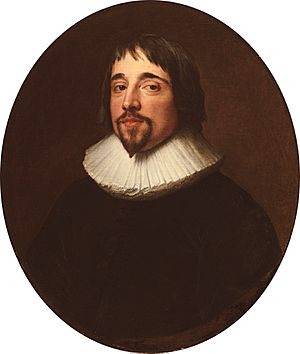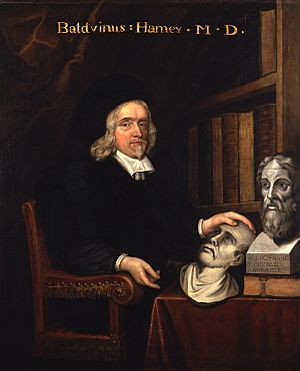Baldwin Hamey the Younger facts for kids

Baldwin Hamey the Younger (1600–1676) was an English doctor. He is mostly remembered today for writing about the lives of other doctors. He earned his M.D. (Doctor of Medicine) degree and was a Fellow of the College of Physicians of London (FRCP).
Contents
Life of Baldwin Hamey
Baldwin Hamey was born in London on April 24, 1600. His parents were from Flanders and the Netherlands. He was the oldest son of Baldwin Hamey the Elder.
Early Studies and Travel
In May 1617, Baldwin Hamey started studying philosophy at the University of Leyden in the Netherlands. He also visited Oxford University in England in 1621 to study in its library. In August 1625, he planned to sail back to the Netherlands from Hastings, but he was stopped by the local mayor. This actually saved him from a shipwreck! He earned his M.D. degree from Leyden on August 12, 1626.
After finishing his studies, Hamey traveled around Europe. He then became a doctor in Oxford on February 4, 1629.
Working as a Doctor
On January 10, 1633, Hamey became a Fellow of the College of Physicians of London. This was a very important group for doctors. He held many roles there, including:
- Censor (someone who checked on other doctors) eight times, from 1640 to 1654.
- Registrar (keeping records) in 1646 and from 1650 to 1654.
- Treasurer (managing money) from 1664 to 1666.
In 1647, he gave the Gulstonian lectures, which were special talks for the College. He set up his medical practice in a part of London called St. Clement's, Eastcheap. A good friend of his, John Pearson, gave sermons in the local church there.
Later Years and Retirement
Baldwin Hamey stayed in London during the First English Civil War. He supported the King, even though he had to be careful during this time. After the war, when the King returned to power in 1660, Hamey was offered a knighthood, but he politely said no.
He stopped working as a doctor in 1665. He moved to Chelsea, where he passed away on May 14, 1676. He was buried in the local church. His tombstone has his name, the date he died, and a special sentence: "When the breath goeth out of a man he returneth unto his earth."
Hamey's Generous Legacy
Baldwin Hamey was a very wealthy man. He inherited money and also earned a lot from his successful medical practice. He used his wealth to help others.
He supported the education of John Sigismund Clewer at Oxford University. He also gave money to churches. Hamey became a major supporter of the College of Physicians. In 1672, he gave the College an estate (a large piece of land) near Great Ongar in Essex. This gift helped support the doctors who worked at St. Bartholomew's Hospital.
Baldwin Hamey's Writings
Baldwin Hamey wrote several important works. His doctoral paper, called De Angina, was published. He also left many of his handwritten notes and books to the College of Physicians. Some of his notable works include:
- Bustorum aliquot Reliquiæ: This book started in 1628 and tells the stories of 53 other doctors who lived at the same time as Hamey. It begins with an account of Theodore Goulston.
- Universa Medicina: A large book filled with his notes on medicine.
- Gulstonian Lectures: The notes from the special talks he gave at the College of Physicians.
- Notes on Aristophanes: His thoughts and notes on the ancient Greek writer Aristophanes.
In 1693, Adam Littleton edited and published Hamey's work about the Hippocratic oath. This is a special promise that doctors make to practice medicine ethically.
Hamey's Family Life
Baldwin Hamey married Ann Petin, who was from Rotterdam. They did not have any children.


